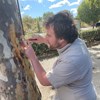Canker Stain of Plane

Forest Research
I had the opportunity to visit the south of France to see the extent of damage caused by Ceratocystis platani (Canker Stain of Plane) to the plane trees in and around Avignon. The ‘Cerato tour’ was organised by a colleague in Forest Research and included two colleagues from Forestry Commission Plant Health Team. There were several aims of the tour: to see some of the impacts of the disease and control measures used, to understand the surveillance carried out in the area and to observe practical sampling and diagnostics. This experience would leave us in a better-informed position in the event of an outbreak in the UK.
The tour was led by the regional Arboricultural Consultant who has many years of experience working with Canker Stain of Plane (CSP). We were shown around his quarantine laboratory where he carries out diagnostic tests to confirm the presence of CSP.
This disease has been devastating to London plane trees around the southeast of France. It has been spreading for many years and is causing significant problems on the Canal du Midi and around Avignon. Whilst not in the UK there have been some detections of CSP in Nantes and Paris and it is getting closer.
Stem lesions of Canker Stain of Plane. The lesions can be made more visible by wetting them as seen in the right-hand photograph. The stem lesions and bark cracking as a result of CSP will be present all year round.
Whilst we were looking for Ceratocystis platani we did come across another priority pest which is the Plane lace bug (Corythucha ciliata) which causes stippling damage as seen in the photographs below.
As Plant Health Week draws nearer, it coincides with the flushing of London planes. Whilst CSP can cause wilting of trees, at this time of year you may observe London planes with leaves that have brown staining along the veins and brown, crinkled patches on predominantly green leaves. This could be the result of anthracnose of plane (Apiognomonia veneta), an endemic fungus which an can cause blights of the leaf, twigs and buds. In severe cases the symptoms of anthracnose can be very striking. However, the impact is generally temporary causing a brief period where there the amount of foliage is limited, and small twigs have died. Later in the growing season, the tree will produce a second flush of leaves. Badly affected trees can look unsightly for several years. The disease is more commonly found in years where there has been a prolonged, mild wet spring.
Frost damage can also resemble anthracnose, however there will be no evidence of cankers on the twigs and there will be an absence of staining in the wood below affected buds.
Another foliar disease which affects London plane is powdery mildew caused by the fungus Erysiphe platani. A white silvery coating on leaves which may be chlorotic in colour is evidence of powdery mildew and potentially the leaves will become distorted and shrivelled. Like anthracnose, the disease is mainly an aesthetic issue on mature trees. Favourable conditions for the fungus are similar to anthracnose where a moist spring coupled with drought stress over the summer can lead to an increased number of infections.
The best time of year to check for symptoms of CSP is during the later part of the summer where wilting will be very pronounced due to the demand for water being at its highest for the tree. However sudden discolouration of the foliage and wilting could occur at any time whilst the tree is in leaf.
CSP is a quarantine organism and a notifiable pathogen and if you think you have found it you must report it either through TreeAlert if in Great Britain or the Tree Check website in Northern Ireland.
By the end of the visit, we were left with an appreciation of the impact of the fungus on the London plane trees in Avignon and the surrounding area; and the constraints of managing trees in an area with high heritage value.



